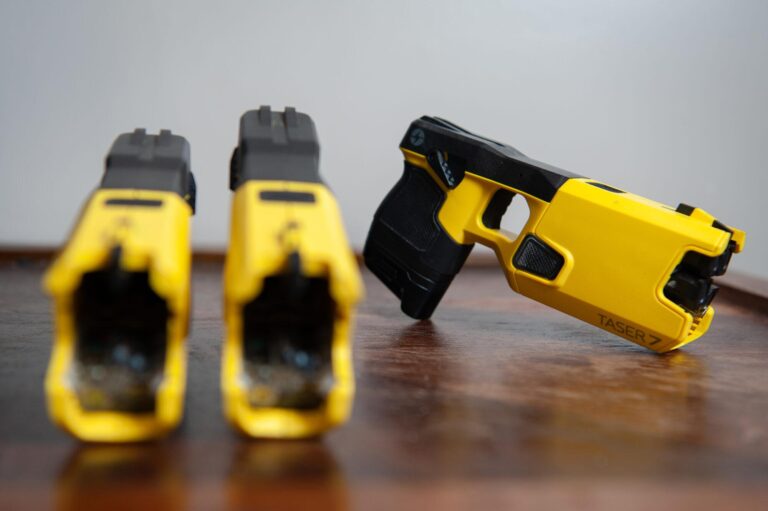Table of Contents
- Mississippi Legislative Shift on Police Tactics and Use of Force
- Impact on Law Enforcement Procedures and Officer Training
- Community Response and Public Safety Considerations
- Recommendations for Alternative Non-Lethal Policing Methods
- The Conclusion
Mississippi Legislative Shift on Police Tactics and Use of Force
The Mississippi legislature has enacted a significant policy change that will prohibit law enforcement officers from using stun guns as a method of force starting July 2025. This decision follows extensive debates and consultations aimed at addressing concerns over the safety, ethics, and community impact of stun gun applications during police interventions. The move reflects a broader reevaluation of police tactics statewide, focusing on minimizing harm and encouraging alternative, less injurious techniques in de-escalation scenarios.
Key elements of the new law include:
- Comprehensive training requirements: Officers will receive enhanced instruction on non-force techniques.
- Implementation timelines: Transition provisions ensuring agencies have adequate time to revise protocols and re-train personnel.
- Accountability measures: Mandatory reporting and review processes for use-of-force incidents.
- Community involvement: Engagement programs to foster trust and transparency between police and residents.
Impact on Law Enforcement Procedures and Officer Training
The prohibition on stun guns necessitates significant adjustments in daily operational protocols for Mississippi law enforcement agencies. Officers will need to rely more heavily on alternative tactics that prioritize de-escalation and physical restraint techniques, which may prolong encounters but aim to reduce the risk of excessive force. Departments are expected to revise their standard operating procedures to reflect these changes, placing increased emphasis on non-lethal methods such as verbal negotiation, use of batons, and enhanced situational awareness. This shift challenges agencies to strike a balance between maintaining public safety and adhering to new legislative limits on force.
Training programs are set to undergo a comprehensive overhaul to equip officers with the skills necessary for this transition. Enhanced scenario-based training modules will be introduced, focusing on conflict resolution and physical control without electronic devices. Additionally, law enforcement academies and continuing education initiatives will emphasize the development of emotional intelligence and crisis intervention strategies. The ban not only reshapes tactical drills but also compels police forces to cultivate a culture of restraint and accountability, ensuring that officers can effectively manage volatile situations without stun guns.
- Revised Use-of-Force Policies: Encouraging minimal force with alternative tools.
- Expanded De-escalation Training: Reducing violent confrontations through communication.
- Focus on Physical Control Techniques: Strengthening defensive tactics training.
- Crisis Intervention Certification: Preparing officers to manage mental health emergencies.
Community Response and Public Safety Considerations
Reactions from community groups have been mixed, reflecting deep concerns and hopes about the impact of this significant policy shift. Advocacy organizations focusing on civil rights have applauded the decision, emphasizing that removing stun guns from law enforcement’s toolkit could reduce instances of excessive force, particularly in marginalized neighborhoods. Meanwhile, some local residents expressed unease about potential challenges in police effectiveness, fearing gaps in non-lethal options during volatile encounters.
Public safety experts have highlighted several key considerations moving forward:
- The necessity to enhance officer training on alternative de-escalation techniques.
- Development of comprehensive protocols to safely manage high-risk situations without stun guns.
- Continuous dialogue between law enforcement and community leaders to build trust and transparency.
- Monitoring and evaluation mechanisms to assess the law’s impact on crime rates and police-citizen interactions.
Recommendations for Alternative Non-Lethal Policing Methods
As Mississippi prepares to phase out stun guns, law enforcement agencies are urged to adopt a suite of alternative non-lethal tools designed to maintain public safety while minimizing harm. Technologies such as bean bag rounds, foam batons, and pepper ball launchers offer officers effective options to de-escalate potentially volatile situations without resorting to lethal force. Equally important is the integration of body-worn cameras and real-time communication devices, which enhance transparency and accountability during police-citizen interactions.
Beyond equipment, emphasis must pivot towards enhanced training programs that center on conflict resolution, mental health crisis intervention, and cultural competency. Departments should prioritize workshops on verbal de-escalation techniques and implicit bias to reduce the likelihood of confrontation escalating. Additionally, community policing initiatives can build trust and foster cooperation, enabling law enforcement to work proactively with residents rather than reactively enforcing order.
- Deployment of soft impact munitions like rubber bullets and bean bag rounds
- Use of pepper spray and tear gas in controlled, limited situations
- Incorporation of advanced communication tools to coordinate response teams effectively
- Comprehensive de-escalation and crisis intervention training for officers
- Expansion of community policing and engagement programs aimed at building mutual trust
The Conclusion
As Mississippi moves forward with the ban on police use of stun guns set to take effect in July 2025, the state joins a growing number of jurisdictions reevaluating law enforcement tactics and their impact on public safety and civil rights. The decision reflects ongoing debates surrounding the balance between effective policing and the protection of individual liberties. Stakeholders from across the spectrum, including law enforcement agencies, advocacy groups, and community members, will be closely monitoring how this policy shift influences policing outcomes in the months and years ahead.Check Our Other Blogs
- StunGun – Your Trusted Source for Stun Guns, Laws, and Self-Defense Tips
- PepperSprayLaws – Your Trusted Resource for Pepper Spray Information
- StunGunLaws – Your Trusted Guide to Stun Gun Legality and Safety





